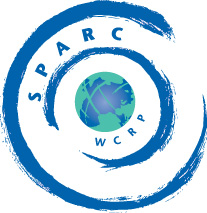SPARC INITIATIVES : Chemistry and Microphysics in the Lower Stratosphere and
Upper Troposphere
Chair: A.R.Ravishankara (USA), e-mail: ravi@al.noaa.gov).
Trace species in the upper troposphere/lower stratosphere, in
particular ozone, are crucial in determining the overall climatic
effects of the stratosphere and of stratospheric changes, and
in assessing the potential impact of aircraft emissions. The observation
that, contrary to original expectations, the most significant
ozone depletion has occurred in the region just above the tropopause
rather than in the upper stratosphere has given added importance
to an improved understanding of the chemistry in this region of
the atmosphere. The type of activities to be undertaken include
study of:
- NOx distribution in the upper troposphere,
- the parameterization of heterogeneous chemistry in models,
- comparisons of chemical models,
- comparative modelling studies of the impact of aircraft emissions,
- use of aircraft and satellite measurements (especially for model
validation),
- parameterization of climate-chemistry interactions,
- supporting laboratory investigations.
The topics concerned are of direct interest to both SPARC and
the (IGBP) International Global Atmospheric Chemistry
(IGAC) project, and close co-operation is maintained to see that key
issues are properly addressed.
The objectives of this initiative are described in the SPARC Implementation Plan.
Two SPARC/IGAC joint tasks:
- Analysis and evaluation of data on peroxy radicals.
Peroxy radicals play a major role in the production of ozone in
the troposphere and also affect the chemistry of the lower stratosphere.
Because of various experimental difficulties, laboratory measurements
have been confined to a few methods. Progress in other aspects
of this chemistry has not been evaluated and taken into account
to define the reactivity of peroxy radicals. Therefore, the group,
whose members have contributed significantly to the previous studies,
are evaluating the data systematically. The outcome of this project
will be critically evaluated data that can be used for atmospheric
modeling. From the outset, the task required a paper published
in a high-profile refereed journal (with prominent acknowledgement
to SPARC).
Leader of the task: Dr. Geoffrey Tyndall, NCAR, Boulder, CO, USA
Members: Dr. R. A. Cox, Cambridge, UK - Prof. Robert Lesclaux, CNRS-Bordeaux,
France - Dr. Geert Moortgat, MPI-Chemie, Mainz, Germany - Dr.
Timothy Wallington, FORD motor Co., USA - Dr. A. R. Ravishankara,
NOAA Aeronomy Lab, Boulder CO, USA.
- Quantum yield for O(1D) production in ozone photolysis.
Photolysis of ozone to give the first electronically excited oxygen
atom, followed by its reaction with water and methane, is the
primary source of the OH radicals in the lower and middle atmosphere.
There is a lot of new data from physical chemistry and chemical
physics communities on this process. This data has to be evaluated
and presented in a form accessible to atmospheric chemists. Therefore,
a joint SPARC/IGAC task was started. As in the case of the first
task, a peer-reviewed publication is planned. The data assembly
process has begun and the project is expected to be completed
late this year. The members are likely to meet in England before
or after the IUGG meeting in Birmingham.
Leader of the task: Prof. Yutaka Matsumi, Nagoya University
Members: Prof. Gus Hancock, Oxford University, UK - Dr. Anthony Hynes,
University of Miami, USA - Prof. A. Comes, Frankfurt, Germany
- Dr. A. R. Ravishankara, NOAA Aeronomy Lab, USA.

Workshops
Publications
Report of the Strasbourg Workshop on UT/LS Heterogeneous Chemistry
A.R.Ravishankara, SPARC Newsletter 9, July 1997.
Small Organic Peroxy Radicals: Big Player in Ozone Production,
Geoffrey Tyndall et al., SPARC Newsletter 15, July 2000.
The atmospheric chemistry of small organic peroxy radicals,
G.S. Tyndall, R. A. Cox, C. Granier et al., J. Geophys. Res., in press, 2001.
Quantum yields for production of O(1D) in the ultraviolet photolysis of ozone:
Recommandation based on evaluation of laboratory data,
Y. Matsumi, F.J. Comes, G. Hancock et al., J. Geophs. Res, submitted 2001.
 Last update: May 18, 2001
Last update: May 18, 2001

![]()

![]()
![]() Last update: May 18, 2001
Last update: May 18, 2001